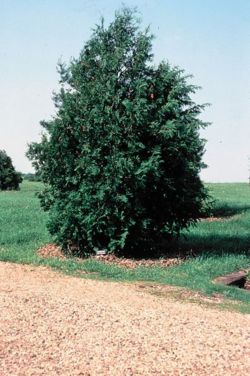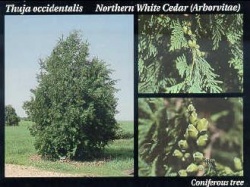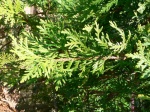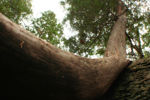Northern whitecedar
| Thuja occidentalis |
|---|

|
| Scientific Classification |
|
| Binomial Name |
|
Thuja occidentalis |

|
Northern Whitecedar is a species of conifers given the scientific name Thuja occidentalis. It is also known as eastern arborvitae, American arborvitae, techny arborvitae, eastern whitecedar (even though its is not a cedar), or just arborvitae. The Thuja occidentalis is native to northeastern U.S., southern and eastern Tennessee, most of Canada, and the Appalachian Mountains.[1] The oils from this tree supposedly treat warts, and you can make tea from this tree that helps treat scurvy.
Anatomy
This tree is small, about 10m to 20m in height and has a .4m trunk diameter. They have a reddish-brownish or grayish brown colored bark, which is furrowed and peels in longs strips. Its foliage has scale-like leaves that are about 3mm to 5mm wide, and there usually are 6 to eight overlapping scales on the leaf. [2] Sometimes the trunk is divided into two to three secondary stems and the seeds of these trees are cones. [3]The wood of this tree is also rot and insect resistant.[4]
Reproduction
Reproduces by using seeds and vegetatively by layering. As young as 6 years in age, the tree will start producing cones, and at the age of 30, it will start producing large amounts of cones, but it isn’t until the age of 75 that its starts reproducing the best. Good crops usually happen in two to five year intervals and medium crops grow between those good years. The seeds of the tree have lateral wings and can be blown by the wind about 150ft to 200ft away from the tree.
Vegetative reproduction happens when there is a lot of moisture and the right conditions. Layering happens when trees in a swamp forest fall or tip slowly to the ground. The branches on a fallen tree will grow vertically into a new tree as long as the roots of the fallen tree still work. Eventually, because of the weight of the new tree from the branch, the stem will touch soil and will start putting out roots.[5]
Ecology
This tree thrives in cool, moist areas, and places that contain a lot of nutrients. They can be found near streams or other water drainage places, organic soils, and on calcareous mineral soils.[6] They also grow in areas where other trees usually don’t do so well. For example, near cliffs and in swamps. [7]
This tree also helps out the wildlife habitat. During the winter, deer use the tree for both shelter [8] and for food since they find the bark delicious.
The largest known tree of this type is 34m tall and has a diameter or 175cm. The oldest living one found is a little older than 1,000 years, but there has also been a dead one found with over 1,500 growth rings. [9]
Some other animals that use this tree for shelter and a place to live like the snowshoe hare, porcupine, and red squirrels.[10]
Uses
This is a popular ornamental tree and can be used as screens and hedges. In Europe, this type of tree is specially used in parks and in cemeteries.
Organic medications containing oils from this tree claim to eliminate warts (“Forces of Nature: Warts No More”). But there is no scientific evidence to prove that its really true and if it really helps.
The needles from this tree has also been boiled to make tea. It has 50mg of Vitamin C per 100mg and it helps to cure scurvy.[11] In the sixteenth century when French explorer Jacques Cartier learned from the Indians that this tree helps treat scurvy, he gave it its name arborvitae which means “tree of life”.[12] The wood from this tree is very good for products that are in contact with water and soil because of it being rot and insect resistant. Some things that it is used for are fencing, posts, saunas, paneling, and boats like canoes.
Gallery
References








